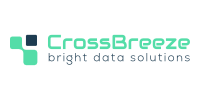The challenge
A large financial institution was running into the limitations of a traditional data engineering process. The team was working sequentially, with many dependencies between analysts, engineers and testers. This resulted in long lead times and limited flexibility in the development process.
The CrossBreeze approach
Together with the client, CrossBreeze introduced a fundamentally different way of working: Model Driven Data Engineering. This method revolves around splitting the functional logic (‘what’) and the technology (‘how’). This created a new team structure with clear responsibilities and more autonomy.
- Modeling teams: small teams of 3 to 6 modelers, responsible for functionally modeling the logic based on input from the organization.
- Technical team: a team of 6 to 7 devops and data engineers, responsible for translating models into software.
This division allows teams to work largely independently of each other and makes the development process much more scalable.
Automation of the chain
An important part of this transformation is the complete automation of the development process. Thanks to CrossBreeze’s tooling and working method, new software is automatically generated, rolled out and tested as soon as a model is modified. This allows:
- fewer manual steps are required,
- teams can deliver multiple times per day,
- the error sensitivity is greatly reduced,
- and the dependency between teams is minimal.
Result: from puzzle pieces to a complete whole
In the new process, each team works on its own ‘puzzle piece’ within the chain. Think of the metaphor of building a car: one team develops the engine, the other the wheels. Once all the parts are ready, they are combined into one whole. This modular approach allows each team to develop and deliver at its own pace, without slowing down the rest of the process.
Customised tools and knowledge
CrossBreeze not only provided the methodology, but also the right tools and support. We:
- trained the modelers in this new way of working,
- implemented a set of open source tools for modeling, software generation and test automation,
- and continuously tailor these tools to the customer’s needs and architecture.
Because the tools are open source, other organizations also benefit from improvements and further developments.
The impact
The financial institution now works with faster releases, fewer errors and more focus per team. Meetings are shorter and more effective, and new functionality is live within a few hours if desired.
Also ready for more speed and fewer errors?
Model Driven Data Engineering can also help your organization work faster, more scalable and more error-resistant. Feel free to contact us – we are happy to show you what is possible.



